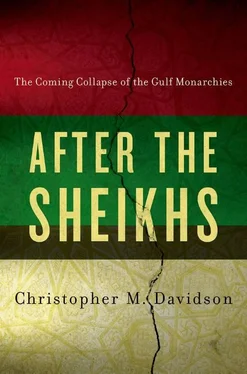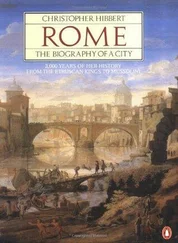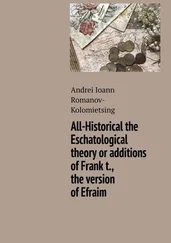Given the obvious secrecy surrounding the source of the wealth, it is now little more than a guessing game as to the exact size of the fortunes that have been built up by the Gulf’s ruling families. It is likely that they are now the richest families in the world, with substantial assets placed overseas in the name of private shell companies rather than via official sovereign wealth funds. Occasionally there are glimpses and hints of the extent of the wealth, though these are usually the result of overseas scandals and investigations. In the early 1990s, for example, the extensive international investigation into the collapse of the Bank of Credit Commerce International — headquartered in Abu Dhabi, managed by expatriate Pakistani bankers, and part funded by the ruling family — temporarily lifted the lid on the ‘web-like multi-layered structure of shell companies and private investments established on behalf of key family members’. [530] 69. Davidson (2005), chapter 4.
Similarly, a recently leaked US diplomatic cable, written in 1996, provided a detailed account of the mechanisms of wealth distribution (and the resulting waste) within Saudi Arabia’s ruling family. In addition to reporting that ‘corruption abounds largely unchecked’ in Saudi Arabia, the cable concludes that ‘…getting a grip on royal family excesses is at the top of priorities’ for the kingdom, and that ‘…many in the Kingdom feel that royal greed has gone beyond the bounds of reason’. In particular, the cable explains that the Ministry for Finance siphons off a portion of the country’s hydrocarbon revenues. This is then distributed in varying portions to each ruling family member in the form of monthly stipends. Back in 1996 this was believed to be on a scale ranging from $800 per month for the thousands of lowly princes up to $270,000 for the few hundred top princes and their families. Moreover, it was reported that many princes could gain bonuses of about $3 million for getting married or building palaces, with further increases to their stipends for having more children. For about five or six princes it was thought that stipends equivalent to a million barrels of oil per day were being distributed. Today these figures are likely to be much higher with the number of recipient princes having greatly increased. Other, almost institutionalised benefits enjoyed by the ruling family were believed to be the ‘royal rake-offs’ resulting from confiscating land from non-ruling family members and then selling it on to the government, bank loans which were defaulted on, and princes acting as ‘super sponsors’ to hundred of expatriates under the aforementioned kafala system. [531] 70. Wikileaks, US Embassy Riyadh, 1 November 1996.
The exact mechanisms of ruling family enrichment vary in the other Gulf monarchies, with some — such as those in Kuwait, where stipends are more modest — being more transparent than others. Nevertheless in all cases their wealth has continued to grow largely unchecked, regardless of economic downswings or recessions. In the most recent Forbes magazine royal rich list — published in 2009—Abu Dhabi’s Khalifa bin Zayed Al-Nahyan is estimated to be worth $18 billion, while Saudi Arabia’s Abdullah bin Abdulaziz Al-Saud is estimated to be $17 billion. Close behind is thought to be Dubai’s Muhammad bin Rashid Al-Maktoum at $12 billion, while Qatar’s Hamad bin Khalifa Al-Thani is estimated to be worth $2 billion, Oman’s Sultan Qaboos bin Said Al-Said about $700 million, and Kuwait’s Sabah Al-Ahmed Al-Jaber Al-Sabah about $400 million. [532] 71. Forbes , 17 June 2009.
However, given that these estimates were produced soon after losses resulting from the credit crunch, the figures today are likely to be a little higher.
For many years the most noticeable manifestations of this wealth were overseas, with the various ruling families buying and building stately homes in Britain, Spain, Morocco, and other locations in addition to hundreds of other properties including game reserves, penthouse apartments, and farmsteads. This continues today, more or less unabated, with most Gulf monarchs and other powerful individuals seeking both solid foreign investments and safe overseas boltholes. A good recent example is the Abu Dhabi ruler’s new palace in the Seychelles. Having personally spent $2 million on buying up land in the Seychelles, the UAE’s presidential office has also spent $15 million on improving the country’s water piping. Meanwhile the UAE’s federal government has also pledged more than $130 million in aid to the island nation, has provided it with fast attack patrol boats, and has pumped in $30 million to help alleviate government debts. [533] 72. Wall Street Journal , 9 September 2010.
More recently, however, the relative discretion of overseas palace-building seems to have been abandoned, with dozens of new palaces now being built at home. In Oman, for example, despite his public image of modesty and the country’s clearly limited resources, the aging Qaboos is understood to own at least eight palaces including the heavily guarded Royal Court at Seeb and an extensive waterfront palace in his hometown of Salalah. The palaces also have berthing facilities for super yachts, of which Qaboos is thought to own at least five, including the Al-Behar , which was the largest yacht built in Italy during the 1980s, and the 150 metre long Al-Said , which was constructed in Germany and houses a helipad, a swimming pool, and space for an orchestra. In Bahrain, the ruling family has been accused of building several new palaces and coastal resorts in recent years on land that was previously public. In early 2010 a group of opposition politicians united across sectarian lines to demand an investigation into such corruption. They collaborated on a report that accused the ruling family of having ‘illegally appropriated one tenth of Bahrain’s scarce public land’. [534] 73. New York Times , 26 August 2010.
Similarly in Abu Dhabi the ruling family has spent the past decade or so colonising almost all of the emirate’s smaller outlying islands, often then building ‘sea palaces’ complete with outdoor swimming pools and extensive berthing facilities. These are now heavily defended, with most having armed patrols along their beachfronts and in some cases Patriot missile batteries discreetly installed. Some of the roads, sewerage facilities and lighting on these islands have been installed by the Abu Dhabi Municipality, despite the land now clearly being in the private hands of the ruling family. Just a few years ago most of these islands were public land, where nationals and expatriates alike could camp and hike. One particularly striking development has been on Futaisi Island, owned by a lesser member of the ruling family, Hamad bin Hamdan Al-Nahyan. Having already built a golf course and a fake fort on the island, in 2011 he began to carve his name ‘Hamad’ in giant letters into the surface of the island. Despite Futaisi being home to mangrove swamps and teeming with gazelles and other wildlife, each letter on the island is a kilometre long and deep enough to be filled with water to allow motor launches to navigate. With the whole name spanning three kilometres it is clearly visible on satellite mapping images. Even more ostentatiously, given that it will be located on the main Abu Dhabi island, is the new UAE Presidential Palace. Although being built by the UAE’s Ministry for Presidential Affairs, it will de facto become the main seat of Abu Dhabi’s ruler and crown prince, given their dominance over the federation. Spanning a secure 150 hectare site, the giant compound will contain several smaller ancillary palaces and be comparable in size to Muammar Gaddafi’s Bab al-Azizia government-cum-residential compound in Tripoli. The construction contract was awarded to a Greek company in 2007 with the value of the deal remaining secret due to a confidentiality agreement signed between the contractor and the Abu Dhabi government. [535] 74. Construction Weekly , 3 August 2010.
Nevertheless its total cost is believed to be at least $490 million. [536] 75. Business Insider , 13 April 2011.
Читать дальше












